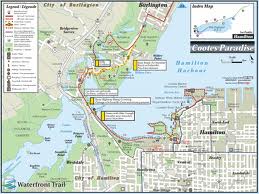 Cootes Paradise, a wetland and woodland covering 840 hectares on the western perimeter of Lake Ontario, is the focus of what may be the largest freshwater restoration project ever attempted, according to research scientists at the Royal Botanical Gardens in Burlington.
Cootes Paradise, a wetland and woodland covering 840 hectares on the western perimeter of Lake Ontario, is the focus of what may be the largest freshwater restoration project ever attempted, according to research scientists at the Royal Botanical Gardens in Burlington.
These days, the Cootes Paradise wetland is little more than a shallow muddy lake. Its once-thriving community of aquatic wildlife has dwindled down to a handful of pollutant-tolerant species such as snapping turtles, gulls, geese, alewife and carp. Only four of 21 species of submergent plants that existed in former days may still be found there, and only 28 of 190 hectares of emergent vegetation remain.
Three kilometres from Hamilton City Hall, Cootes Paradise has been degraded by pollution from Hamilton harbour and toxic effluents from farms above the watershed. Without its protective vegetation, the exposed water is more susceptible to being stirred up by high waves and winds. As well, lack of erosion controls on local streams has increased the amount of silt clouding the water, which has become so murky that aquatic plants do not receive enough sunlight to survive.
Another major factor behind the wetland’s deterioration is the prevalence of carp, a large “introduced” fish that contributes to the turbidity of the waters by stirring up bottom sediments and destroying vegetation (see box). “The carp have locked themselves into a biological niche that sustains their own living conditions at the expense of other species,” says John Hall, a scientist with the federal Department of Fisheries and Oceans who is manager of a $19-million fish and wildlife restoration project for Hamilton harbour.
 An international joint commission began studying the water quality of the Great Lakes in the 1970s after birds with deformed beaks and fish with carcinogenic tumours indicated serious problems. In the 1980s, the commission identified 43 regions (17 in Canada) in strong need of remedial action. The revitalization of Cootes Paradise is part of the larger remedial action plan (RAP) for Hamilton harbour.
An international joint commission began studying the water quality of the Great Lakes in the 1970s after birds with deformed beaks and fish with carcinogenic tumours indicated serious problems. In the 1980s, the commission identified 43 regions (17 in Canada) in strong need of remedial action. The revitalization of Cootes Paradise is part of the larger remedial action plan (RAP) for Hamilton harbour.
One element that distinguishes Cootes Paradise from other localities is the array of world-class institutions in the neighbourhood with the collective know-how and determination to return the marsh to good health. Much of the wooded terrain surrounding the wetland belongs to the Royal Botanical Gardens (RBG), a 53-year-old provincial institution with an international reputation for horticultural preservation. “I don’t suppose there’s an agency anywhere better suited to worry about how to re-establish an aquatic plant community,” says Victor Cairns, manager of fish habitat studies at the nearby Canada Centre for Inland Waters (CCIW), an agency of the federal Department of Fisheries and Oceans.
The RBG has set up a special operation, Project Paradise, to oversee the restoration of the portion of the marsh on its property and to raise $7.5 million for that task. RBG scientists Peter Rice and Len Simser, manager and co-ordinator respectively of Project Paradise, are co-ordinating the contributions of participating specialists at the CCIW and McMaster University in Hamilton. Few wetlands could boast such a wealth of local talent. In addition, Ontario’s Natural Resources and Environment and Energy ministries are lending support and expertise.
Set at the northern limits of the Carolinian life zone, Cootes Paradise lies within one of the most important staging areas for migratory birds on the Great Lakes. Once known for its natural abundance, it must have seemed a natural paradise to early settlers like Charles Durand, who farmed here in the early 1800s. Durand wrote of “limitless flocks of ducks and wild fowl” and game animals like beaver, mink, muskrat and otter. In 1826, British engineer John MacTaggart wrote, “… I have never seen such a variety of wild fowl as come to this place…. It is therefore strongly recommended to ornithologists and sportsmen as a place above all others yet known in Canada most deserving of attention.”
As late as the 1920s, a resident noted, “Wild celery was common and wild rice so abundant that rowing through the marsh, one’s boat would be covered with rice. Water was so clear and food so plentiful that ducks remained in thousands until ice formed.”
A scientific survey taken in 1935 indicated that about 85 per cent of the marsh was covered by emergent aquatic plants like cattails. Today the figure is only about 10 per cent. “Our goal is to restore the marsh to a marsh on the basis of aquatic plants that have largely disappeared,” says Rice. “Our mandate here at the Gardens is to manage our conservation lands as urban wildlife sanctuaries, and that means providing as diverse habitats as we can.”
Last year, the team engaged in much preliminary research to prepare for its unprecedented task. In the summer, the RBG built a wetlands nursery and carried out experiments on aquatic plants and planting techniques. “We found out what works and what doesn’t work,” says Simser, an environmental biologist.
As Rice explains, no textbook contains a step-by-step methodology for restoring a marsh. “It’s a major challenge. It’s a giant research project. There is no off-the-shelf technology to restore wetlands ecosystemically.”
This spring, workers intend to begin replanting on a large scale. To facilitate the work, sections of marsh along the shore are to be cordoned off and drained using semi-submersible elongated plastic tubes that act as portable dams. This technique was used last summer to pump water from a 1/4-hectare section of marsh. Once drained, the area was found to contain about 125 carp, an indication of the high numbers of the problem fish here.
The installation of temporary breakwaters is expected to reduce wave energy, stabilize bottom sediments and improve water clarity. As well, rectangular plastic enclosures may be placed around some sections of vegetation to prevent carp from uprooting young sprouts. “We’ve shown quite clearly that when we can keep carp out of emergent bodies of cattails, for example, they start to regenerate quite quickly,” says Hall. “But when we allow carp access to the same bed of cattails, they keep falling into decline.”
Carp are bottom feeders: they subsist on small organisms that live in the benthic or soil level of the marsh. As they forage continuously for edibles, they repeatedly take in mouthfuls of mud; they filter through the mud for ingestible macrophytes, then spew it out. Especially rambunctious during the spring mating season, carp are as respectful of fragile marine foliage as a bull would be of delicate figurines in a china shop. “Anyone who lives near a wetland can hear them thrashing and rolling about and splashing at all hours for several weeks before and during the spawning season,” says Victor Cairns, CCIW’s manager of fish habitat studies.
Thousands of foraging carp would not take long to stir up the sediments in a clear pool. If that pool has lost much of its vegetation and was subject to high wind and wave action, its waters would quickly become impenetrable to sunshine. “We’re kickstarting the vegetation with the planting program,” Simser declares. “But the key to restoring the habitat is to restructure the fish community by restricting carp access.”
Two highways — 403 and the Queen Elizabeth Way — traverse and bypass Lake Ontario’s roughly triangular western extremity; Cootes Paradise — dirty, derelict, neglected for too many years — lies to the west of Highway 403. The carp barrier, set for construction beneath 403’s romanesque arch by the historic Desjardin Canal, is currently under construction and is due for completion in August; it is set to become operational in the spring of 1995. The barrier “will restrict entry to the marsh by mature carp, while allowing upstream and downstream passage by desirable species,” explained the environmental design firm Beak Consultants in a May 1993 report.
Since Cootes Paradise freezes in winter, carp and other species move out into deeper lake waters in the autumn; their movements have been monitored by radio telemetry. Fish too large to return to the marsh in spring will be automatically detained in a holding tank. Salmon, trout, pike and other desirable species would be manually returned to the marsh, while carp would be destroyed and perhaps used as a soil nutrient; they have little value as food. (“We ‘re working to ensure that anything we do is done in a humane manner,” says Hall.) The object is to encourage new pike, bass and perch populations and to provide habitat again for ducks, mink, muskrat, turtles and other wetland dependent species.
Another fish barrier is slated for construction at the mouth of nearby Grindstone Creek. Both the Cootes Paradise and Grindstone Creek barriers are meant as only temporary installations. Eventually, through a restructuring of the fish community, the carp’s natural predators will be able to return to Cootes Paradise to keep the carp population in check.
Keith Rogers is co-ordinator of the Hamilton Harbour RAP and a research scientist with the National Water Research Institute of Environment Canada. Rogers and others involved in the project say that their goal is to return the marsh to a self-sustaining condition of good health; they regard the first five to ten years as critical. “If, after five years, we’ve removed the carp stress, we’ll remove the barrier and let the system run naturally. We’ll be satisfied to let things run in a natural state. We’re trying to remove the stress with minimal intrusion to produce what we hope will be a natural way for a system to operate.”
Rogers points out that the word “restoration” may be somewhat misleading, since Cootes Paradise will probably never be the same as it was. “We’re not going back to the pristine conditions of the past,” he says. “There’s been far too much influence by European settlement in the area. But it’s an attempt to restore enough of it that it’s relatively well balanced.”
Eventually, plans call for the development of a system of nature trails featuring unobtrusive marsh boardwalks and observation towers. The idea is to make the harbour the sort of people place that it always should have been but never was. “The 400,000 people who live in this area have decided that they want to take back their harbour,” says Rice. “It has been devoted to industry and shipping for too many decades.”
The shoreline is a special environment that affords vital protection and habitat for many species, Rogers explains. The loss of an “in-between” zone separating the beach from deep and open waters deprives fingerlings and small species of places to hide from predators, thus decreasing their chances of survival. “The health of Lake Ontario depends very critically on the health of the shallow areas around the shores. If you could envision Lake Ontario with a tiled or sheet-steel wall around it, it would be a most unhealthy system. You’ve got to have marshes and beaches, the normal things around a lake, in order for it to function normally.”
But the western terminus of Lake Ontario might just as well be walled, since relatively few local residents have positive encounters with the waterfront. “I know people in their sixties and seventies who remember when they were kids, swimming in the harbour,” Rogers says. “People in their thirties and forties never had that experience, and they’ve been told since the 1960s that it isn’t a very nice place to be. We hope to change that.”
According to the old saying, one swallow does not a summer make. In Cootes Paradise, the return of sizable populations of winged species like the American bittern, marsh wren or black tern, or herpetiles like the bullfrog, would indicate that the habitat restoration is succeeding. While not all of the three salamander species, six snake, six frog, one toad and four turtle species observed in 1928 could be expected to return, numbers of reptiles and amphibians should increase along with those of fish, birds and small mammals. According to Simser and others, bio-diversity is the key to the health of the marsh.
How to decide whether the restoration is working? “Just the present or absence of a species doesn’t necessary represent in itself a healthy or diverse community,” says Simser. “What you have to look at is the population levels and their distribution; the evenness of the species. Say we have, as an example, one black tern that finds conditions to its liking in any given year, and breeds in the marsh. That doesn’t necessarily mean that we have a healthy marsh. Fifteen to twenty black terns spread out evenly over the marsh in discrete territories would be a far better indicator.”
John Hall notes that after the marsh is restored and the fish barriers removed, the experience gained in Cootes Paradise could be useful elsewhere. “Some very good research is being carried out here on a continuing basis. That will translate itself into a base of knowledge and techniques that can then be applied to other marshes in the Great Lakes requiring rehabilitation.”
In the meantime, thanks to numerous concerned agencies, Cootes Paradise’s future seems far less murky than its troubled waters. That may reassure Federation of Ontario Naturalists members planning to attend the annual conference and general meeting at McMaster University in May.
“A lot of expertise and good will is coming together from different levels of government and the community to bring about a project like this,” says John Struger, president of the Hamilton Naturalist’s Club, which has donated $32,000 toward restoring fish and wildlife in Hamilton harbour. “This is an important message that we’re sending out to the rest of Canada.” ♦
© 1994






